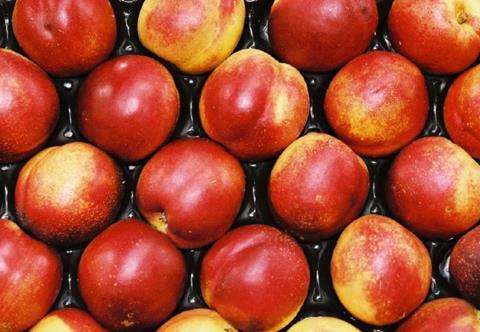Britain’s stonefruit market landscape is changing as higher prices curb purchases, and chief consumers are getting younger

UK stonefruit sales have been on a downward trajectory in recent years as Northern and Southern Hemisphere supply issues, together with UK grocery inflation, have conspired to dent purchase volumes. And 2023/24 was no exception.
Over the 12 months to February, the British stonefruit market saw a 1.6 per cent rise in value but a 7.6 per cent fall in volume over the prior year period, according to Kantar Worldpanel.
From a production perspective, climate change and inflation continue to challenge growers. Shazad Rehman of Spanish producer Royal says the main countries and growing regions for stonefruit on both sides of the equator are experiencing climate issues, be it with water supply, frost or extreme heat. This is having a detrimental impact on volume, fruit quality and length of season. UK retailers are expanding their sourcing portfolio, while growers are looking to improve end-of-season varieties in a bid to mitigate the issues.
Europe’s peach and nectarine volumes last summer were forecast to rise 12 per cent year-on-year mostly thanks to a bigger predicted crop in Spain, the EU’s major stonefruit producer. However, a spokeswoman for Spanish grower-shipper El Ciruelo says Spain’s export season to the UK started very late in June, missing peak production volumes in April and May.
The UK’s winter stonefruit typically comes from South Africa, where adverse weather and infrastructure challenges have created supply chain issues over past few years. This season, though, industry body Hortgro reports a 20 per cent rise in nectarine exports off the back of increased plantings and better returns. Peach and plum export volumes are expected to be similar to last season’s figures, when 795,000 cartons of peaches and 2.4m cartons of plums were sent to the UK. But apricot volumes are down considerably, Hortgro says. Port delays continue to blight RSA exports this winter, Hortgro admits. However, general manager Jacques du Preez says the industry is working hard to find long-term solutions.
Meanwhile, at UK store level, consumers are moderating their stonefruit consumption due to inflation-driven higher prices, purchasing them less frequently and in smaller quantities, according to Kantar. Cherries, nectarines and plums have all witnessed significant price-hikes, with cherries experiencing the most substantial rise of 16.7 per cent within the last 12 months.
The stonefruit consumer demographic is also changing, the market researcher says. While retirees have traditionally been the primary consumers, there is a discernible shift towards empty nesters and older dependents, reveals Kantar Worldpanel consumer insight director Laura Fry. “Individuals aged 55-64 show a growing interest in stonefruits, indicating changing preferences within this demographic segment,” she says. “Moreover, the share of retirees among stonefruit consumers has decreased slightly, suggesting a diversification in consumer base.”
Over the last 12 months, Lidl, Waitrose and M&S have emerged as the frontrunners in both value and volume performance within the UK stonefruit category, Fry adds. “Their ability to outperform competitors underscores their effective strategies in meeting consumer demand,” she says.



